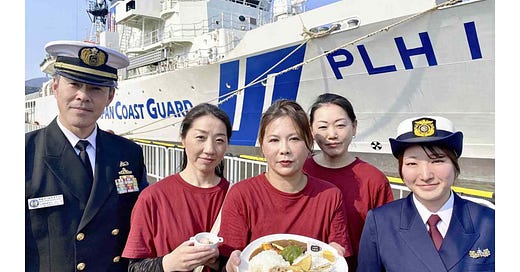Curry Diplomacy: Maritime Kitchens and the Soft Power of Stew
In Maizuru, Kyoto Prefecture—home to significant bases of both the Maritime Self-Defense Force (MSDF) and the Japan Coast Guard (JCG)—local restaurants are now serving aigake curry, a split-plate dish that features curries developed aboard MSDF and JCG vessels. The initiative began in April 2025 and was coordinated by the Maizuru Chamber of Commerce and Industry, with the stated aim of strengthening community ties and local tourism.
At first glance, it’s an appealing civic gesture. Maizuru is the only municipality in Japan where both the MSDF and the JCG maintain major operational bases. With support from the local chamber of commerce, recipes from JCG patrol boats and MSDF destroyers have been shared with civilian restaurants. In April 2025, four local eateries began serving Kaiho Curry—the Coast Guard’s answer to the already popular MSDF’s Kaiji Curry, which has been available in Maizuru since 2017. The launch event featured tasting sessions hosted on the JCG’s western base, where a rice mound shaped like the Maizuru Crane Bridge divided the two curries: one a buttery beef stew topped with fried vegetables, the other a seaweed- and chicken-based variant rich in broth and root vegetables.
But beneath the promotional veneer lies a more complex narrative. The MSDF’s curry tradition originates not with the postwar Self-Defense Forces, but with the Imperial Japanese Navy, which institutionalized curry and rice in the late 19th century as a preventive measure against beriberi—a disease then ravaging its conscripted sailors. Modeled on British naval cuisine, the dish became a practical solution to vitamin B1 deficiency and was quickly routinized into naval life, with Friday curry becoming standard practice aboard MSDF to this day. The meal’s endurance across regime change—imperial to postwar—signals how institutional memory can be embedded in something as seemingly banal as a stew.
In recent years, that memory has been recontextualized for civilian consumption. As part of broader efforts to humanize and localize military institutions, the MSDF began releasing shipboard recipes to commercial kitchens. Kaiji Curry was the result: a branded, regionally distinct food product that quietly reinforces the presence and presumed benevolence of military forces in everyday life. Kaiho Curry extends this logic. Through shared branding, promotional events, and symbolic plate design, it integrates Japan’s maritime defense apparatus into the rhythms of civic gastronomy.
This is soft power in one of its more edible forms. The blending of state institutions with culinary culture invites comfort rather than scrutiny. Eating curry becomes a way to support “those who protect the sea,” even as the lines between commemoration, nationalism, and regional branding blur. The dish’s appeal is not just its flavor but its framing: a narrative of cooperation, protection, and localized pride. Yet that very framing risks effacing the complex histories and present tensions that define Japan’s maritime institutions—histories shaped not only by public service but by imperial expansion, postwar demilitarization, and ongoing debates about the role of the military in civilian life.
You can read the Yomiuri article at: https://tinyurl.com/ycyyfd4k




